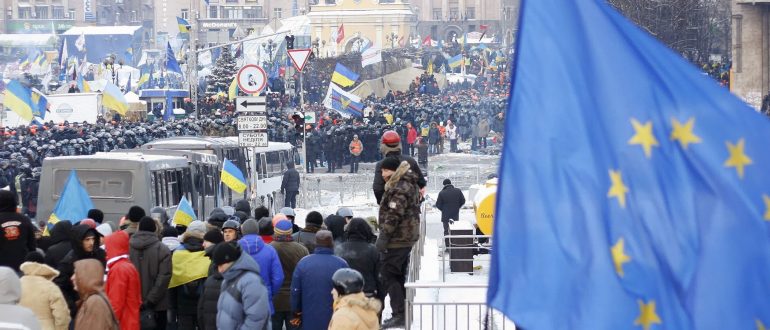
Changes in Ukraine’s Global Perception – How to stop the immanent decline.
When Ukraine was first included in the 2021 Global Soft Power Index (Brand Finance, 2021, p.19) a ranking often used by foreign policy strategists to determine the level of a country’s recognition, reputation, and influence, it only ranked 55st out of 100 countries. Two years later Ukraine gained the most points among all countries and moved up to the 37th place (Brand Finance, 2023, p.40). This clearly was a result of the Russian war unleashed in Europe and the global attention and solidarity for the nation of “heroism” and “democracy” as a recent study shows, are the most prevalent attributes associated with Ukraine (Lee, 2022, Sec. 4).
But more than the situation itself, it was the reaction of Kyiv’s public diplomacy strategists, who were able to secure Ukraine’s unprecedented rise. At the heart of Ukraine’s public diplomacy strategy lies a commitment to transparency, authenticity, and citizen empowerment. This starts with the way President Volodymyr Zelensky is communicating and extends all the way down to the successful mobilization of civil initiatives all over the world. By harnessing the power of social media, digital platforms, and citizen journalism, Ukraine has effectively bypassed traditional channels of communication to engage directly with audiences worldwide. Whether amplifying voices of dissent, debunking disinformation, or showcasing cultural heritage, Ukraine has adeptly utilized digital tools to shape narratives and challenge prevailing stereotypes.
A shift in global perception
The second year of the full-scale war however, witnessed a reasonable shift. Ukraine fell back to the 44th place of the 2024 Global Soft Power Index (Brand Finance, 2024, p.7) showing a gradual, though anticipated, decrease in global attention towards Ukraine. This doesn’t come as a surprise considering a new hot conflict in the Middle East, blockage of military aid or a drop of 40% in social-media publications about Ukraine (Brand Ukraine, 2024, p.4).
In this situation Ukraine’s public diplomacy, recently rebranded as “Wartime Diplomacy” by Ukraine’s Foreign Minister Dmytro Kuleba, is more than ever looking for solutions to stop the alleged compassion fatigue. And this despite already “reinventing diplomacy” as German Foreign Minister Annalena Baerbock described Ukrainian diplomatic efforts in December 2022. All to push international recognition for Ukrainian society, culture and history.
One of such campaigns is the promotion of the international recognition of the Holodomor – the genocide against the Ukrainian population caused by the Soviet regime – which since 2015 was one of the central efforts of Ukrainian with little to no success. In 2022 Ukrainian diplomats achieved to convince 15 new countries to adopt and 9 more to consider relevant recognition at the parliamentary level (MFA Ukraine, 2024).
Another paradigm of Ukraine’s efforts in strengthening their national identity on the international stage is persuading foreign institutions to implement the Ukrainian transcription for names of cities and regions. These names are often transcribed from the Russian alphabet and therefore pronounced wrongly. Such adaptations were implemented by changing e.g. “Kiev” into “Kyiv“ in the US or recently when the German embassy in Ukraine’s capital decided to change their spelling from the Russian transcribed “Kiew” to “Kyjiw” (Federal Foreign Office, 2024). As these examples seem insignificant, Ukrainian scholars and diplomats desperately tried to win over western institutions for these changes for years.
The list of new initiatives promoting the recognition of Ukraine doesn’t end there. In 2022 the Ukrainian Street initiative was created, calling cities to rename streets where Russian embassies and consulates are located. This resulted in the renaming of 20 streets and squares in 16 countries (MFA Ukraine, 2024). A large assistance in these initiatives were also the actively included 17-30 million Ukrainians worldwide (Federal Agency for Civic Education,2022).
Although the biggest strength of Ukraine was to activate the potential of civic engagement it also strengthened the institutionalization of their cultural representations. This shows in the opening of two branches (Berlin and Paris) of the Ukrainian institute with the mission to promote better knowledge and understanding of Ukraine internationally and develop cultural relations between Ukraine and other countries. This expansion was achieved despite the budget allocated to the institute was not significantly increased (MFA Ukraine, Passport of Budget Program 2021/24, 2024).
Lately however, the initiatives of the Ministry of Foreign Affairs of Ukraine falter. The European Union announced the resumption of tariffs on Ukrainian imports, private donations for certain German organizations providing humanitarian aid to Ukraine fell by 93% (Diakonie Katastrophenhilfe, 2024) and publications about Ukraine in international media dropped by over 20% (Brand Ukraine, 2024, p.4).
What now?
Ukraine didn’t vanish from the global agenda and even with fewer media mentions the country maintains its reputation as politically and diplomatically influential, militarily strong, and well-recognized internationally. Most of the western countries back Ukraine with military, humanitarian and financial aid, bringing hope to the Ukrainian people.
However, the support shows first cracks as military situation further intensifies and perception deteriorated across several indicators. So, what are the possibilities of Ukraine’s Wartime Diplomacy entering 2024?
As compassion and news fatigue are one of the essential factors of planning Ukraine’s further strategic communication as the decline of media coverage by more than 20% show (Ibid.), the country must find their own ways to relocate itself into the center of attention. Ukraine has already shown a significant potential in generating its own news, using current developments and setting them into context with corelating e.g. historic events in identified regions, broadcasting a certain narrative to boost regional attention.
Additionally, Ukraine should amplify its strategic communication by relining it with well based plans addressing certain interests rather than trying to spread surface-oriented attention. A good example is Ukraine’s initiative which aimed to convince Germany to a release of their Leopard tanks, strongly requested by the Ukrainian military. When four months of Ukraine’s public request, by government officials didn’t change the decisions about the supply of the tanks. In only three weeks since the Ukrainian foreign ministry launched its public initiative concentrating efforts on this topic creating corresponding hashtags, media campaigns and mobilizing civil actors in the target region of German the German NO to the Leopards changed into a YES (Federal Government Germany, 2023).
This also shows the importance of the adaption of Ukraine’s strategic communication to certain countries or regions, leveraging accurately gathered and interpreted data on their culture, history, political and socioeconomic contexts, and existing awareness levels about Ukraine.
First steps manifesting those thoughts were already made with e.g. the creation of a new official country account addressing especially the Arabic speaking public, showing a lower awareness towards Ukraine. These target groups should also be addressed with different narratives as the cultural beliefs deviate significantly from the ones in e.g. Europe.
In general, Ukraine’s social media can already be regarded as a great success as the total reach of Ukraine’s MFA and Ukraine.ua digital channels are over 1.6 billion since the beginning of the full-scale invasion, placing it under the Top 5 official accounts of countries. This reach is due not only the war but also the quick reaction on news demand by the users.
A test for Ukraine’s fortitude
Ukraine’s public diplomacy success can be attributed to its adept navigation of geopolitical fault lines and strategic partnerships. By forging alliances with nations sharing equal values, international organizations, and civil society actors, Ukraine has amplified its message and garnered critical support for its territorial integrity, sovereignty, and modern reforms.
Although the developments on the frontline, which brought a great threat to the population, were met with extraordinary courage and resilience, led to a significant surge in global attention and altered perceptions of the country, now a certain compassion fatigue occurred. In the last year the war evolved into a new reality causing a predictable decrease in attention and media coverage.
Only a comprehensive approach to strategic communication concentrating on the yet to come challenges including well prepared planning, institutionalization and regional adaptation are the most important tools Ukrainian Wartime Diplomacy can use. The push of its strategic narratives from being merely a topic of discussion and a reaction to ongoing events to being a subject shaping the discussion will be essential in Ukraine’s approach for upholding its positive perception levels, compassion and vital aid.
Disclaimer: The views and opinions expressed in this article are those of the author and do not necessarily reflect the opinion of any Ukrainian government institutions.
Bibliography
- Brand Finance, “Global Soft Power Index 2021” 2021, accessed March 20th, 2024. https://brandirectory.com/rankings/nation-brands/2021.
- Brand Finance, “Global Soft Power Index 2022” 2022, accessed March 20th, 2024. https://brandirectory.com/rankings/nation-brands/2022.
- Brand Finance, “Global Soft Power Index 2023” 2023, accessed March 20th, 2024. https://brandfinance.com/events/global-soft-power-index-2023-case-of-ukraine.
- Ministry of Foreign Affairs of Ukraine, “Wartime Diplomacy 2022-2023”, accessed March 21st, 2024. https://wartimediplomacy.mfa.gov.ua/en.
- Brand Ukraine, “Ukraine’s Global Perception Report 2024”, accessed March 21st, 2024. https://static.brandirectory.com/reports/brand-finance-soft-power-index-2024-digital.pdf.
- The Federal Government of Germany, “Pressemitteilung 24, Mittwoch, 25. Januar 2023”, accessed March 21st, 2024. https://www.bundesregierung.de/breg-de/aktuelles/bundesregierung-kuendigt-lieferung-von-leopard-2-panzern-an-die-ukraine-an-2160236.
- Lee, S.T. “A battle for foreign perceptions: Ukraine’s country image in the 2022 war with Russia”. Place Brand Public Dipl. 19, 345–358 (2023).https://doi.org/10.1057/s41254-022-00284-0.
- Federal Agency for Civic Education, „Die Ukraine – Abwanderung und Vertreibung in Vergangenheit und Gegenwart 2022“, accessed March 22th, 2024. https://www.bpb.de/themen/migration-integration/laenderprofile/509978/die-ukraine-abwanderung-und-vertreibung-in-vergangenheit-und-gegenwart/.
- The Ministry of Foreign Affairs of Ukraine, “Passport of the budget program for 2024 “Financial support for ensuring the international positive image of Ukraine, supporting the activities of the Ukrainian Institute, measures to maintain relations with Ukrainians living outside Ukraine”, accessed March 21st, 2024. https://mfa.gov.ua/storage/app/sites/1/budget/passport%202024/pasport-po-1401110.pdf.
- The Ministry of Foreign Affairs of Ukraine, “Passport of the budget program for 2021 “Financial support for ensuring the international positive image of Ukraine, supporting the activities of the Ukrainian Institute, measures to maintain relations with Ukrainians living outside Ukraine”, accessed March 21st, 2024.
- Federal Foreign Office of the Federal Republic of Germany, “Länderverzeichnis Länderverzeichnis für den amtlichen Gebrauch in der Bundesrepublik Deutschland“, 2024, accessed April 2, 2024. https://www.auswaertiges-amt.de/blob/215256/8d820b1b6285a9a5340d5db1e1c623c0/laenderverzeichnis-data.pdf.
- Diakonie Katastrophenhilfe, press release 21.02.2024 „Diakonie Katastrophenhilfe ruft zu Spenden auf Ukrainehilfe: „Wir dürfen nicht müde werden zu helfen“, accessed April 3, 2024. https://www.diakonie-katastrophenhilfe.de/pressemeldung/ukrainehilfe-wir-duerfen-nicht-muede-werden-zu-helfen.

Alexander Blümel
Alexander Blümel studierte Ökonomie in der Ukraine sowie Rechtswissenschaften in Deutschland und den USA, wo er seinen Abschluss in Internationalem Recht mit Auszeichnung für Excellence in Global Leadership machte. Seit 2022 arbeitet er für das Außenministerium der Ukraine im Generalkonsulat der Ukraine in Hamburg und ist Leiter der strategischen Kommunikation und Public Relations.


